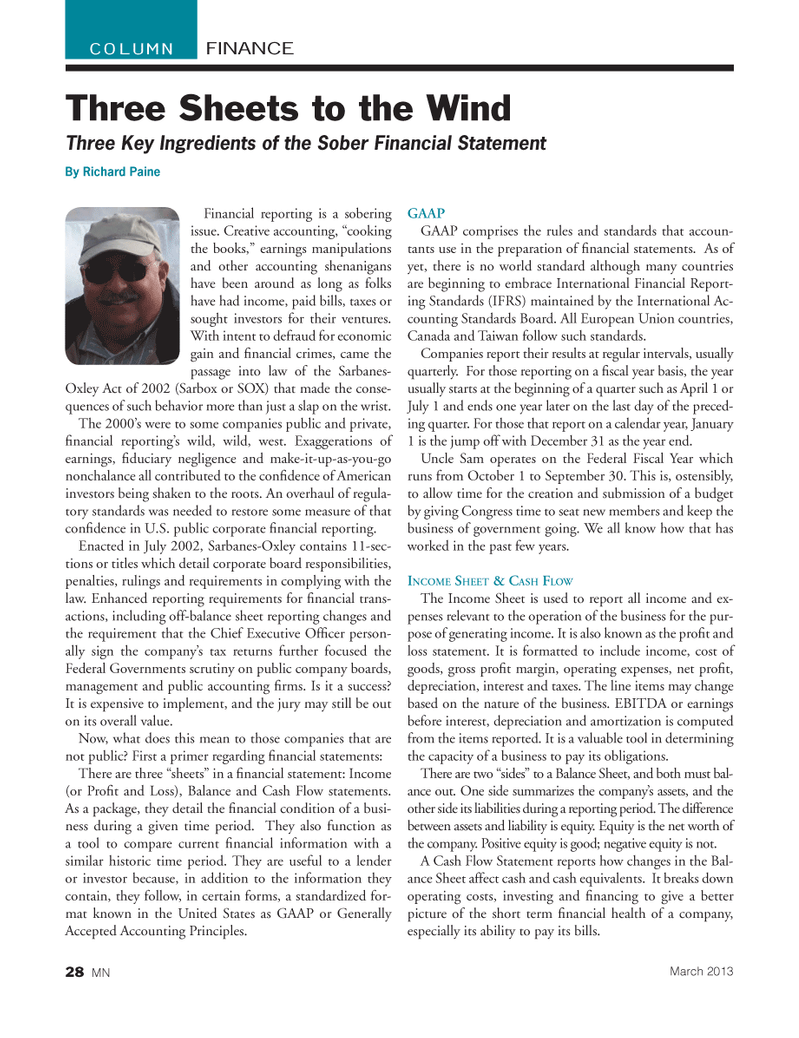
Page 28: of Marine News Magazine (March 2013)
Shipyard Report: Construction & Repair
Read this page in Pdf, Flash or Html5 edition of March 2013 Marine News Magazine
Financial reporting is a sobering issue. Creative accounting, ?cooking the books,? earnings manipulations and other accounting shenanigans have been around as long as folks have had income, paid bills, taxes or sought investors for their ventures. With intent to defraud for economic gain and nancial crimes, came the passage into law of the Sarbanes- Oxley Act of 2002 (Sarbox or SOX) that made the conse- quences of such behavior more than just a slap on the wrist. The 2000?s were to some companies public and private, nancial reporting?s wild, wild, west. Exaggerations of earnings, duciary negligence and make-it-up-as-you-go nonchalance all contributed to the con dence of American investors being shaken to the roots. An overhaul of regula- tory standards was needed to restore some measure of that con dence in U.S. public corporate nancial reporting. Enacted in July 2002, Sarbanes-Oxley contains 11-sec- tions or titles which detail corporate board responsibilities, penalties, rulings and requirements in complying with the law. Enhanced reporting requirements for nancial trans- actions, including off-balance sheet reporting changes and the requirement that the Chief Executive Of cer person- ally sign the company?s tax returns further focused the Federal Governments scrutiny on public company boards, management and public accounting rms. Is it a success? It is expensive to implement, and the jury may still be out on its overall value. Now, what does this mean to those companies that are not public? First a primer regarding nancial statements: There are three ?sheets? in a nancial statement: Income (or Pro t and Loss), Balance and Cash Flow statements. As a package, they detail the nancial condition of a busi- ness during a given time period. They also function as a tool to compare current nancial information with a similar historic time period. They are useful to a lender or investor because, in addition to the information they contain, they follow, in certain forms, a standardized for- mat known in the United States as GAAP or Generally Accepted Accounting Principles. GAAPGAAP comprises the rules and standards that accoun- tants use in the preparation of nancial statements. As of yet, there is no world standard although many countries are beginning to embrace International Financial Report- ing Standards (IFRS) maintained by the International Ac- counting Standards Board. All European Union countries, Canada and Taiwan follow such standards. Companies report their results at regular intervals, usually quarterly. For those reporting on a scal year basis, the year usually starts at the beginning of a quarter such as April 1 or July 1 and ends one year later on the last day of the preced- ing quarter. For those that report on a calendar year, January 1 is the jump off with December 31 as the year end. Uncle Sam operates on the Federal Fiscal Year which runs from October 1 to September 30. This is, ostensibly, to allow time for the creation and submission of a budget by giving Congress time to seat new members and keep the business of government going. We all know how that has worked in the past few years. INCOME SHEET & CASH FLOW The Income Sheet is used to report all income and ex- penses relevant to the operation of the business for the pur- pose of generating income. It is also known as the pro t and loss statement. It is formatted to include income, cost of goods, gross pro t margin, operating expenses, net pro t, depreciation, interest and taxes. The line items may change based on the nature of the business. EBITDA or earnings before interest, depreciation and amortization is computed from the items reported. It is a valuable tool in determining the capacity of a business to pay its obligations.There are two ?sides? to a Balance Sheet, and both must bal- ance out. One side summarizes the company?s assets, and the other side its liabilities during a reporting period. The difference between assets and liability is equity. Equity is the net worth of the company. Positive equity is good; negative equity is not. A Cash Flow Statement reports how changes in the Bal- ance Sheet affect cash and cash equivalents. It breaks down operating costs, investing and nancing to give a better picture of the short term nancial health of a company, especially its ability to pay its bills.FINANCECOLUMNThree Sheets to the Wind Three Key Ingredients of the Sober Financial Statement By Richard Paine March 2013 28 MNMN March2013 Layout 18-31.indd 28MN March2013 Layout 18-31.indd 283/5/2013 10:50:18 AM3/5/2013 10:50:18 AM

 27
27

 29
29
